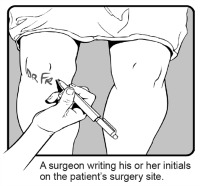Every day, according to one of the latest and most carefully calculated estimates, thousands of Americans suffer injuries or die as a direct result of preventable medical mistakes. Errors made by doctors, surgeons, nurses and pharmacists range from misdiagnosing life-threatening illnesses and performing surgery on the wrong part of the body, and dispensing a prescription drug in the wrong dose or to the wrong patient to neglecting the physical needs of people experiencing health crises.
Writing in the September 2013 issue of the Journal of Patient Safety, researcher John T. James concluded from a meta-analysis of earlier studies that “a lower limit of 210,000 deaths per year was associated with preventable harm in hospitals. Given limitations in the … incompleteness of medical records …, the true number of premature deaths associated with preventable harm to patients was estimated at more than 400,000 per year. Serious harm seems to be 10- to 20-fold more common than lethal harm.”
As shocking as an average of more than 300,000 patients deaths in hospitals seems, that greatly understates the problem by excluding individuals who pass away due to medical malpractice at home and in other non-health care settings. The prevalence of the problem also demands concerted efforts to find solutions.

The first step toward eliminating medical mistakes consists of identifying each one. A survey conducted by a group from the Harvard School of Public Health recently revealed that patients understand this implicitly. According to The Public’s Views on Medical Error in Massachusetts, published in December 2014, the top reasons individuals report instances of medical malpractice that caused them harmed or injured or killed a loved one were:
- Wanted to prevent the same error from happening to someone else — 90 percent
- Wanted someone to help cope with the problems caused by the error — 68 percent
- Were angry and wanted to get it off their chest — 40 percent
- Wanted the person responsible to be punished — 31 percent
- Wanted compensation for harm caused by the error — 17 percent
This is a significant message for those, including many state and federal lawmakers, who constantly call for new restrictions on victims’ rights to report and seek compensation for medical malpractice. The goal of such cases is rarely to maximize financial gain, no matter what hardships a preventable medical mistake inflicted. Rather, the intent of calling negligent health care providers to account is to improve medical care, surgery and pharmacy practice for everyone.
EJL




